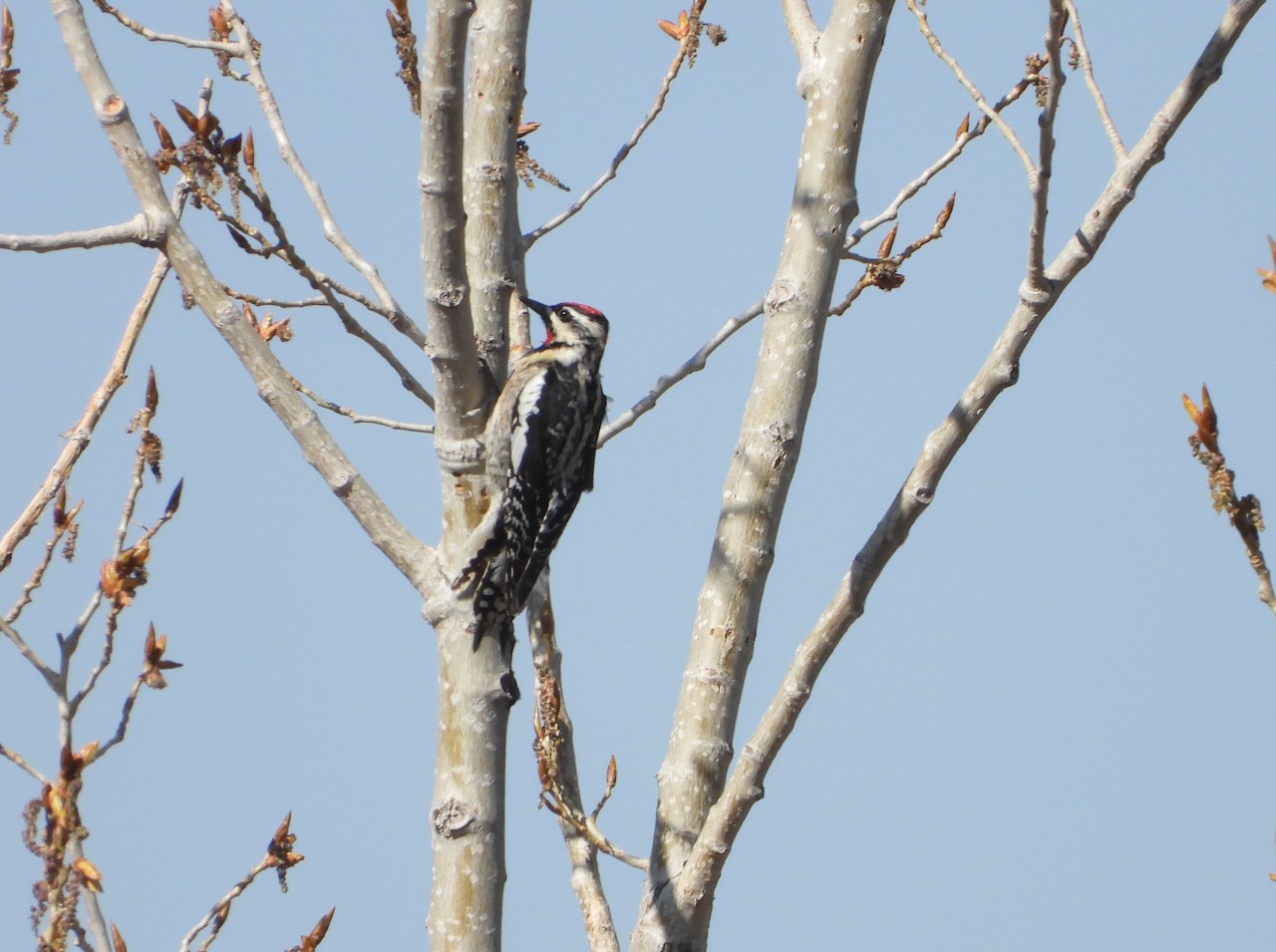Red-naped Sapsucker
Sphyrapicus nuchalis
eBird provides this description for the Red-naped Sapsucker: Striking medium-sized woodpecker of western North America. Long, solid white wing patch helps distinguish it from Downy and Hairy Woodpeckers. Adult male has red cap and throat; females are similar but with white chin; juveniles are messy brownish-gray overall. The namesake red nape is just a small patch and can be difficult to see. Compare with the extremely similar Yellow-bellied Sapsucker, which barely overlaps in range. Note male Red-naped has a more extensive red throat patch with a narrow, broken black border, and the white markings on the back are less extensive and loosely organized into two rows. Head pattern usually separates it from Red-breasted Sapsucker, but beware some hybrids occur. Breeds in montane forest, often with aspens or willows. Descends to lower elevations in winter; occurs in a variety of woodland habitats from the southwestern U.S. to central Mexico. Like other sapsuckers, drills rows of sap wells into tree bark. Listen for irregular drumming (like morse code) and various nasal calls. All About Birds gives this additional descriptive information about this species: Red-naped Sapsuckers are industrious woodpeckers with a taste for sugar. They drill neat little rows of holes in aspen, birch, and willow to lap up the sugary sap that flows out. The presence of sap wells is a good indication that they are around, but so are their harsh wailing cries and stuttered drumming. The red patch on the back of their head helps separate these sharply dressed black-and-white sapsuckers from Yellow-bellied Sapsuckers in the East and Red-breasted Sapsuckers along the western coastal states.
I watched and photographed my first Red-naped Sapsucker on April 20, 2022 at the Randall Davey Audubon Center and Sanctuary in Santa Fe, New Mexico. I had hiked up to the top of the sanctuary property that morning, and had not seen many birds. As I hiked downhill toward the main visitor center, I spotted a pair of woodpeckers high up in a tree near the center and parking area. They looked like Downey or Hairy woodpeckers to me. Once I got home and enlarged my pictures, I realized that they were Red-naped Sapsuckers, new birds to me. Needless to say, I was thrilled to add this beautiful species to my life list!



“Cool Facts” About the Red-naped Sapsucker From All About Birds:
- If you think 3 of the 4 species of sapsucker look remarkably similar, you’re not imagining it. The Red-naped Sapsucker is closely related to Yellow-bellied and Red-breasted Sapsuckers. All 3 were considered the same species and called Yellow-bellied Sapsucker until 1983 when researchers found that they were distinct species. The red-naped hybridizes where it comes in contact with the other two species, and birds intermediate in plumage are sometimes found.
- Sapsuckers, despite what their name implies, do not suck sap, but are specialized for sipping it. Their tongues are shorter than those of other woodpeckers, and do not extend as far out. They lap sap up with the tip of the tongue, which has small hairlike projections that help hold the sap, much like a paintbrush holds paint.
- Sugary sap is a hot commodity and some species, such as the Rufous, Calliope, and Broad-tailed Hummingbirds, follow Red-naped Sapsuckers around, stealing a sweet drink when they can. These hummingbirds can also get an easy meal by picking out insects stuck in the sap.
- Sapsuckers drill hundreds of tiny holes in trees. Surprisingly, most trees survive this quite easily, in the same way that maple trees survive humans tapping them for maple syrup.
- The oldest recorded Red-naped Sapsucker was at least 4 years, 11 months old when she was found in Wyoming in 2011, the same state where she had been banded in 2008.
- Red-naped Sapsucker nest holes make good homes for other species. Many species that nest in holes don’t have a specialized bill needed to carve out their own home, including Mountain Bluebirds, nuthatches, and chickadees. The small holes excavated by sapsuckers provide safe places for smaller hole-nesting birds to nest.